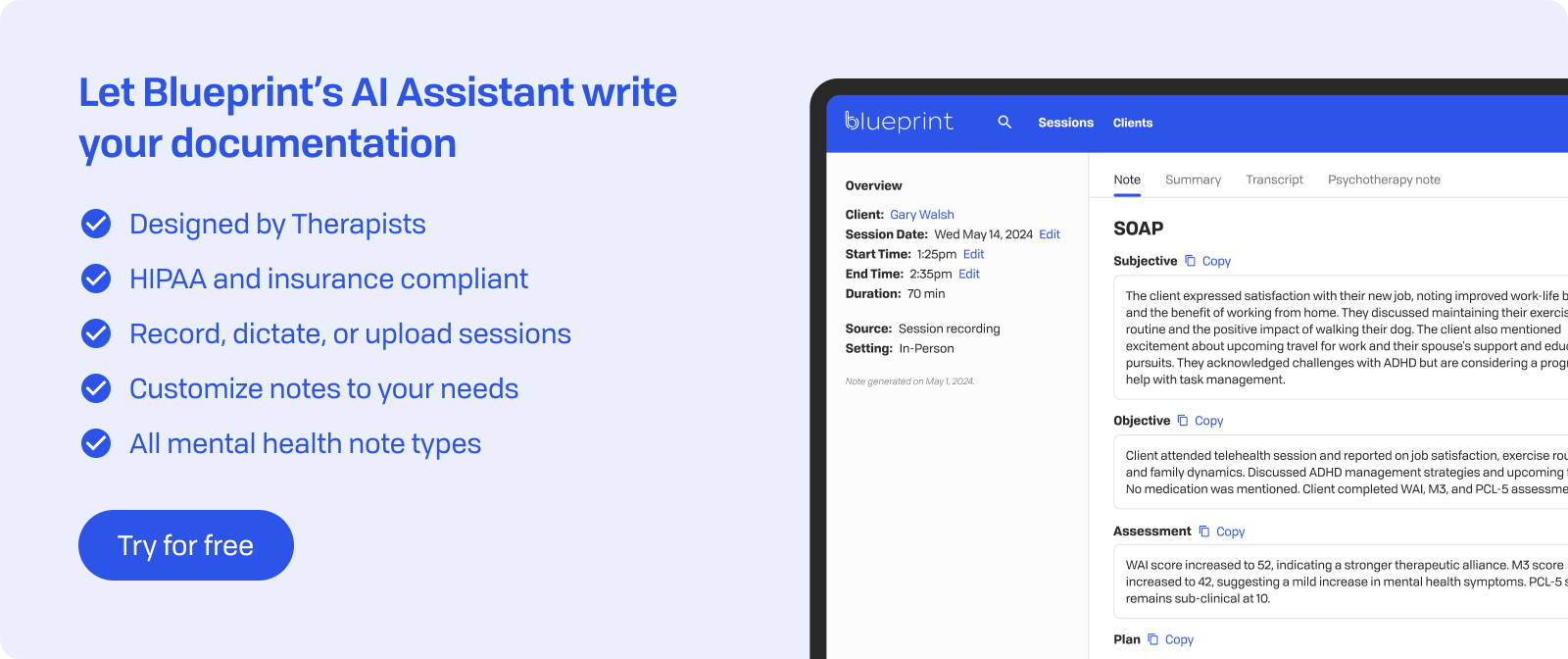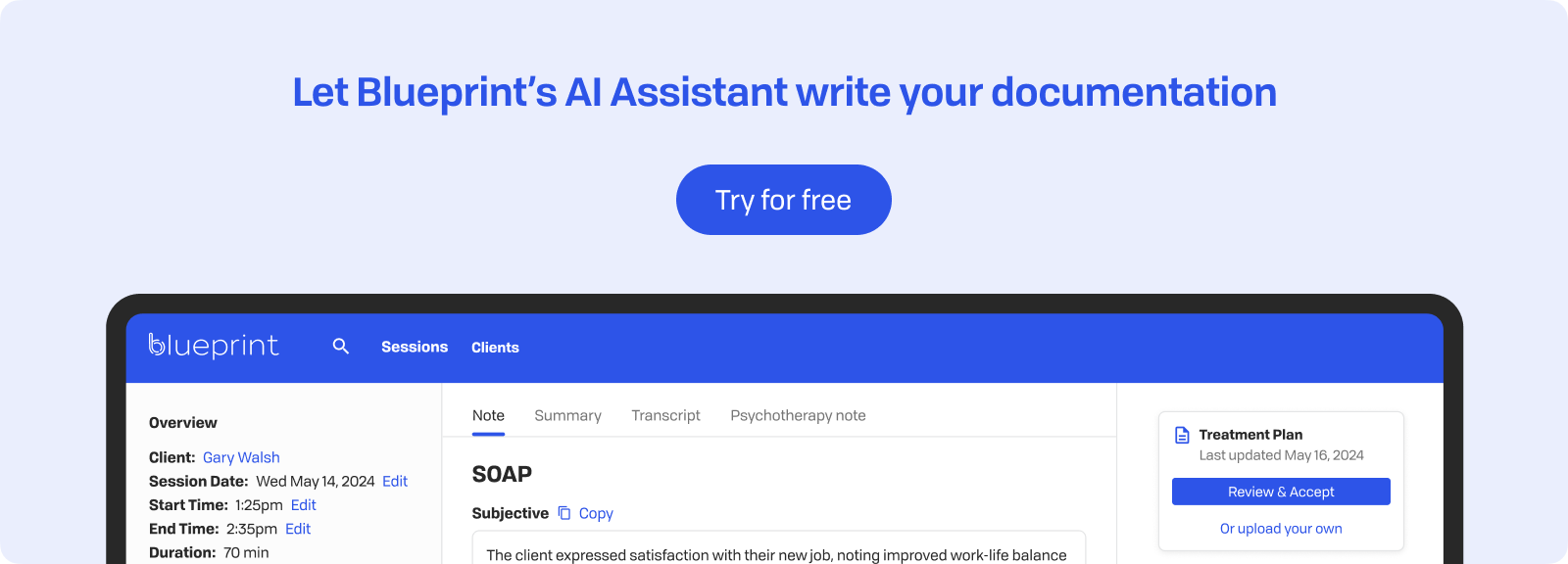In Brief
The therapeutic relationship depends heavily on trust, and this trust can break quickly. Misplacing a file, having a conversation overheard, or sending an unsecured email can turn years of careful practice into a professional disaster. Mental health professionals must protect client information, not just because it's good practice, but because it’s a legal requirement.
HIPAA (Health Insurance Portability and Accountability Act) violations pose serious risks to therapy practices. These violations don't just breach trust; they can lead to investigations, heavy fines, license suspensions, and damage to your professional reputation. The impact goes beyond paperwork issues, potentially affecting every client relationship and the stability of your practice.
Every therapist needs to know what constitutes a violation and how to avoid common errors. This article outlines specific violations that often happen in therapy settings and offers practical advice for staying compliant. Whether you work in private practice or a larger organization, this information will help safeguard both your clients and your career.
What Constitutes a HIPAA Violation
A HIPAA violation happens when someone uses or discloses protected health information (PHI) in ways that break the Privacy Rule or Security Rule. The Privacy Rule controls how PHI can be used and shared, while the Security Rule focuses on electronic PHI protection. Any unauthorized access, use, or disclosure of client information—whether intentional or accidental—counts as a violation.
The difference between civil and criminal violations lies in intent and severity. Civil violations usually involve unintentional breaches or negligence, resulting in monetary penalties ranging from $100 to $50,000 per violation. Criminal violations involve deliberately obtaining or disclosing PHI without authorization, with penalties that include fines up to $250,000 and imprisonment for up to 10 years.
Covered entities include healthcare providers who transmit health information electronically, health plans, and healthcare clearinghouses. As a therapist, if you submit insurance claims electronically or maintain electronic health records, you qualify as a covered entity. This status requires specific actions: implementing administrative, physical, and technical safeguards; training staff on privacy practices; and following strict protocols for PHI handling.
Common causes of violations include discussing clients in public places, leaving files accessible to unauthorized people, and failing to encrypt electronic communications. Improper record disposal, weak password protection, and sharing information without proper authorization also frequently lead to breaches. Even well-intentioned actions, like updating a concerned family member without written consent, can result in violations with serious consequences.

Common HIPAA Violations in Therapy Practices
Mental health professionals face unique challenges in maintaining HIPAA compliance, and violations often occur during routine activities. Recognizing these common pitfalls can help prevent costly mistakes that could harm your practice and client relationships.
- Talking about clients in public spaces: Conversations in elevators, waiting rooms, or break areas can expose PHI to unauthorized listeners. Even discussing cases without names can violate HIPAA if someone could identify the client from context clues.
- Sending unencrypted communications: Standard email and text messages lack proper security for transmitting PHI. Sharing appointment reminders, treatment updates, or clinical information through these channels without encryption or explicit client consent creates significant vulnerability.
- Leaving files and devices unsecured: Physical documents left on desks, in unlocked filing cabinets, or visible on computer screens pose immediate risks. Similarly, logging into EHR systems without proper logout procedures allows unauthorized access to client records.
- Disclosing to unauthorized parties: Well-meaning therapists sometimes share information with concerned family members or friends without proper authorization. HIPAA requires written consent for most disclosures, even to those who seem genuinely invested in the client's well-being.
- Using non-compliant telehealth platforms: Popular video conferencing tools often lack the security features and Business Associate Agreements (BAAs) required for therapeutic use. Conducting sessions through platforms without proper BAAs exposes both therapist and client to potential breaches.
These violations typically result from convenience or oversight rather than malicious intent, yet they carry the same legal consequences. Regular training and systematic safeguards can help prevent these common errors from compromising your practice.

Electronic Communication and HIPAA Compliance
Digital communication introduces significant HIPAA violation risks that many therapists might not fully appreciate. Standard texting and email services send messages without encryption, leaving client information open to interception. Social media platforms add to these risks, as their terms of service often grant the platform rights to user data, which directly conflicts with HIPAA requirements.
Secure client portals and encrypted communication tools offer the necessary protections for digital exchanges. These platforms should provide:
- End-to-end encryption: Protects data during transmission and storage
- Two-factor authentication: Prevents unauthorized access to accounts
- Audit logging: Tracks all access and changes to client information
- Automatic logouts: Reduces risk from unattended devices
Your informed consent documentation for digital communication should clearly address the risks of electronic communication, which platforms you'll use for different types of communication, how clients can opt in or out of digital messaging, and emergency communication protocols. Clients need to understand that while digital communication is convenient, it comes with certain security trade-offs.
Vendor compliance goes beyond communication platforms. Every service that handles client data—EHR systems, billing software, appointment schedulers—must sign a Business Associate Agreement (BAA). This legally binding document ensures vendors maintain HIPAA-compliant practices and accept liability for their role in protecting PHI. Without signed BAAs, you remain fully responsible for any breaches occurring through third-party services, regardless of fault. Always verify vendor compliance before sharing any client information through their systems.

Risk Mitigation and Best Practices
Keeping your practice safe from HIPAA violations involves careful planning and consistent use of protective measures. A thorough strategy covers physical security, digital protections, and operational procedures that work together to reduce risk.
Begin with a formal HIPAA risk assessment to pinpoint vulnerabilities in your practice. This detailed evaluation should:
- Map all PHI locations: Document where client information resides, from paper files to cloud storage.
- Identify potential threats: Consider everything from cyber attacks to accidental disclosures.
- Evaluate current safeguards: Check if existing protections comply with HIPAA requirements.
- Prioritize risks: Allocate resources to the most probable and impactful vulnerabilities.
Physical safeguards protect tangible assets and spaces. Lock filing cabinets containing client records, position computer screens away from public view, and use privacy filters on devices. Install alarm systems for offices storing sensitive materials and implement clean-desk policies requiring staff to secure documents when not in use.
Digital safeguards need equal focus. Use strong, unique passwords for all systems handling PHI, enable automatic screen locks after brief periods of inactivity, and encrypt all devices containing client information. Regular software updates fix security weaknesses that could lead to breaches.
Clear office protocols ensure consistent HIPAA compliance throughout daily operations. Train staff on proper voicemail procedures—avoiding client names and details in messages unless written permission is given. Set guidelines for discussing cases in shared spaces and create emergency response plans for potential breaches. Document these protocols and review them quarterly to ensure they remain effective.
What to Do If a HIPAA Violation Occurs
When you find a HIPAA violation, it's important to act quickly to reduce harm and comply with legal requirements. The steps you take in the first 72 hours can greatly affect the outcome.
Immediate Internal Steps:
- Document everything: Note the date, time, and details of the breach, including how you discovered it.
- Contain the breach: Immediately stop any further unauthorized access or disclosure.
- Assess the scope: Identify which clients were affected and what information was exposed.
- Activate your incident response plan: Follow your established procedures for managing breaches.
Reporting Requirements:
- Internal notification: Inform your privacy officer or practice administrator within 24 hours.
- HHS reporting: Report to the Department of Health and Human Services within 60 days for breaches affecting 500 or more individuals, or annually for smaller breaches.
- Client notification: Notify affected clients as soon as possible, but no later than 60 days after discovering the breach.
Written notifications to clients should include a description of the incident, types of information involved, steps clients should take to protect themselves, and your contact information for questions.
Managing the Aftermath: Consider consulting with legal experts for breaches involving sensitive information or large numbers of clients. An attorney with expertise in healthcare law can help you navigate regulatory requirements and potential liability issues.
Restoring trust involves being open about the corrective actions you've taken, new security measures put in place, and your ongoing commitment to protecting privacy. Offer credit monitoring services if financial information was compromised and plan follow-up communications to show your continued dedication to client safety.

Training, Supervision, and Practice Culture
HIPAA training isn't just a one-time formality—it's an ongoing effort that influences how your practice manages sensitive information. Even solo practitioners need regular updates, as regulations change and complacency can develop over time.
Building a workplace where privacy protection is everyone's duty involves:
- Regular training sessions: Schedule quarterly reviews of HIPAA protocols, rather than limiting it to annual compliance checks
- Open communication: Encourage staff to report near-misses without fear of repercussions
- Clear expectations: Include privacy responsibilities in job descriptions and performance reviews
- Leading by example: Show proper PHI handling in all your interactions
Supervising interns and new staff requires careful attention. Offer thorough orientation before they handle any client information, assign mentors who model correct protocols, and conduct weekly check-ins during their first month to address questions and reinforce standards.
Several resources help practices stay updated with HIPAA regulations:
- Online training platforms: Self-paced courses are available to provide staff with up-to-date education on compliance requirements, privacy practices, and security protocols.
- Professional associations: Many professional associations provide HIPAA updates as part of membership benefits
- Government resources: HHS.gov offers free guidance documents and regulatory updates
- Continuing education: Look for courses offering CEUs and covering HIPAA compliance
Training is only effective when applied. Follow each session with practical exercises where staff demonstrate correct procedures. This hands-on approach ensures that knowledge translates into consistent, compliant behavior throughout your practice.
Key Takeaways
HIPAA violations happen more often than most therapists realize, and even unintentional actions carry serious consequences. Consistent attention to privacy protocols often determines whether a practice thrives or faces regulatory action.
- Adopt encrypted systems, secure storage, and obtain written consent for all communication: Standard email and texts can lead to violations. Use HIPAA-compliant platforms with proper Business Associate Agreements, keep physical files locked, and get explicit written consent before sharing any client information—even with well-meaning family members.
- Conduct regular audits, training sessions, and maintain thorough documentation to prevent and manage breaches: Quarterly risk assessments help identify vulnerabilities before they turn into violations. Document all privacy procedures, consistently train staff, and keep detailed records of your compliance efforts. These practices show due diligence if violations occur.
- Foster a strong privacy culture within your practice to protect clients, clinicians, and your license: Make HIPAA compliance a shared responsibility, from reception staff to clinical supervisors. Encourage reporting of near-misses without punishment, demonstrate proper handling of PHI in all interactions, and integrate privacy considerations into every aspect of practice operations.
Remember that HIPAA compliance isn't about perfection—it's about creating systems that minimize risk and respond appropriately when issues arise. Your clients trust you with their most sensitive information. Protecting that information through careful, consistent practices preserves the therapeutic relationship that makes healing possible. Small daily actions, like logging out of systems and speaking about cases only in private settings, contribute to a practice culture that naturally prevents violations.

How Blueprint can help streamline your workflow
Blueprint is a HIPAA-compliant AI Assistant built with therapists, for the way therapists work. Trusted by over 50,000 clinicians, Blueprint automates progress notes, drafts smart treatment plans, and surfaces actionable insights before, during, and after every client session. That means saving about 5-10 hours each week — so you have more time to focus on what matters most to you.
Try your first five sessions of Blueprint for free. No credit card required, with a 60-day money-back guarantee.
























